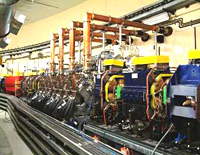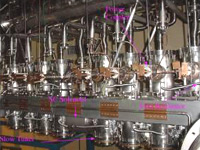 |
 |
|||||||||||||
|
|||||||||||||
|
|||||||||||||
Following suit, in the end of October, Robin Staffin, Associate Director for HEP, DOE Office of Science, made a pilgrimage to India. Accompanied by Shekhar Mishra, a physicist at Fermilab, and Nigel Lockyer, a physicist at the University of Pennsylvania and newly appointed director of TRIUMF, the trio toured India's particle physics laboratories with a mission: strengthen ILC collaboration between the U.S. and India. After meeting with a number of Indian officials that included Kapil Sibel, the Science Minister of India, Thirumalachari Ramasami, Secretary for the Department of Science and Technology, and Satish Kulkarni, US Embassy Counselor of Science and Technology, their assignment took several steps closer to becoming a mission accomplished. "India's science and technology base is very broad, and we are very excited about their capabilities," Staffin said. "We were very encouraged by their interest and enthusiasm. There is a long history of collaboration between the U.S. and India, and we hope that it can be continued." With an agenda that included tours of the Raja Ramanna Centre for Advanced Technology (RRCAT) in Indore, the Bhabha Atomic Research Centre (BARC), the Tata Institute of Fundamental Research (TIFR), both in Mumbai, and the Inter-University Accelerator Centre in New Delhi, the group had the opportunity to see first-hand all of India's technological capabilities for contributing to ILC R&D. Conversations with lab directors followed each tour to discuss collaborating on superconducting RF activities. As a result of the meetings, a Memorandum of Understanding will be drafted between Fermilab and the Indian labs to make ILC cavities with an ultimate goal of building a complete cryomodule. "They are very anxious to collaborate on R&D for the ILC," Lockyer said. "They have an extremely competent operation with very modern facilities. We need to follow through and make this happen." During their time in Mumbai, Lockyer, Mishra and Staffin had the opportunity to meet with Anil Kakodkar, Chairman of the Atomic Energy Commission and Secretary of the Department of Atomic Energy. In charge of all the labs in India, Kakodkar emphasised the importance of training future generations of scientists. "His main mission is to attract young people to science," Lockyer said. "The ILC will excite the minds of young people, and he believes that the educational impact of the project will carry India forward." Following their discussion, Kakodkar and Staffin agreed to jointly organise a workshop on particle technology in India in 2007. In April, India will release a five-year plan for science and technology, which will determine their level of participation in ILC R&D. In the meantime, plans are currently underway to bring a number of Indian physicists to the U.S. to work on cavity processing, cryomodule design and vertical testing. "They need to see it first hand," Lockyer continued. "Before the end of the year, we hope to have begun a number of these projects." -- Elizabeth Clements |
|||||||||||||
| © International Linear Collider |

